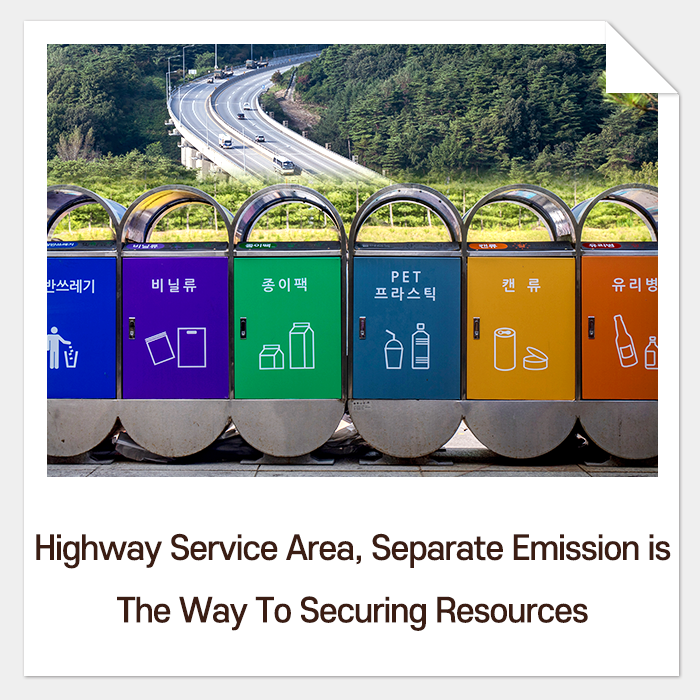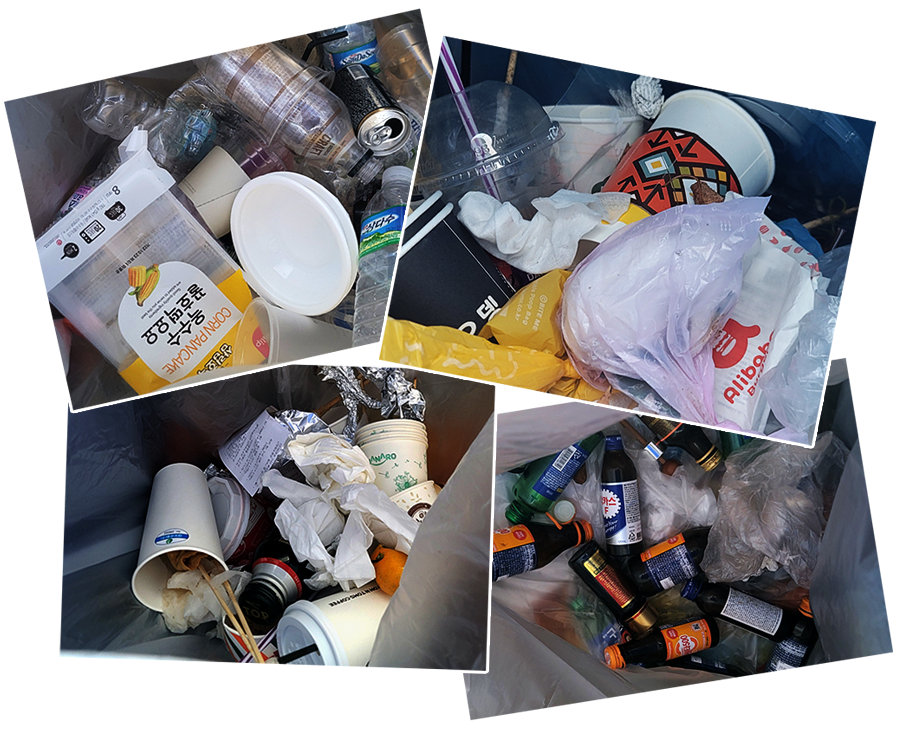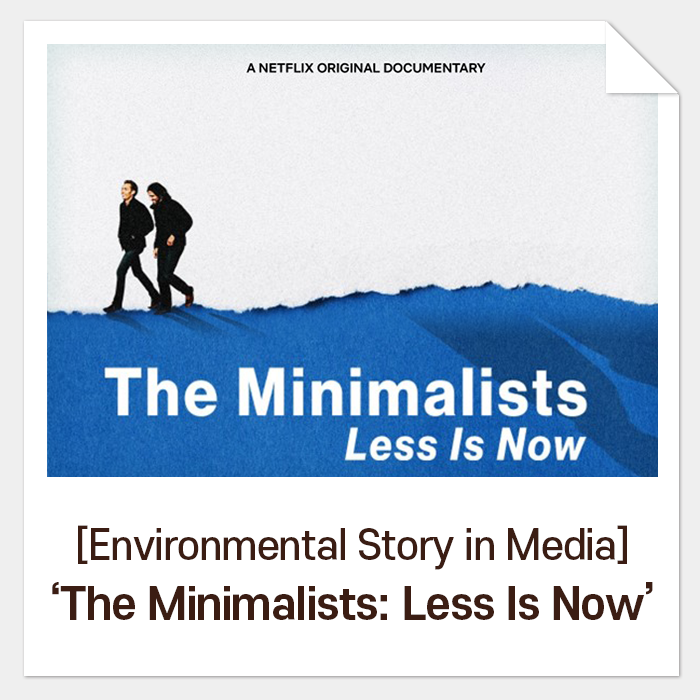Highway Service Area, Separate Emission is The Way To Securing Resources
Korea is one of the few countries where you can enjoy the changes of seasons over time because of its four distinctive seasons. To relish the autumn trees dressed up in gold, the Korea Forest Service publishes a map of the peak autumn leaves at the end of every September for people to go to the so-called ‘Maple Festival’ to appreciate the magnificent view. Although it may vary depending on the region and tree species, the autumn leaves began in late October this year, without fail. Particularly this fall, COVID-19 has subsided to some extent with eased social distancing, many people visited mountains and valleys to see autumn leaves.
The New Trend of Highway Service Area
When you are on the road to see the autumn leaves, visiting the ‘highway service area’ is a must. Starting 1971 with the Chupungryeong Service Area, the very first Korea’s highway service area, there are a total of 207 highway service areas currently operating across Korea. The winner of 2007 Korean Architecture Award, Deokpyeong Eco-Service Area, introduced a new paradigm of how highway service areas are beyond simply space for taking a brief break, filling up gas, using restrooms and grabbing a bite. This place has evolved into an extraordinary place with a well-decorated garden and convenient facilities that provides sanitary and diverse food, place to shop and even a theme park for the visitors to have longer stay at the highway service area so they can relieve the tiredness of driving on the highway.


Let’s take a look at the sales ranking of highway service areas as of 2018, before COVID-19:
1. Deokpyeong Eco-Service Area (about 50 billion won)
2. Haengdam Island Service Area (about 34 billion won)
3. Siheung Haneul Service Area (about 27.7 billion won)
4. Anseong Service Area (about 27.1 billion won)
5. Cheonan Service Area (about 20.9 billion won)
As major companies dive into the highway service area business, the Korea Expressway Corporation and the government announced a mid-to long-term master plan for the innovative operation of the highway service area facilities to develop customer-oriented highway service areas with multi-angulated rest areas and themed zones .
It can be said that the trend of highway service areas is a combined distribution and experience space. Then, what are the most popular products at these service areas? It is coffee beverages, which takes about 41% of the total sales of the top 10 items at highway service areas as of the Lunar New Year holiday in 2022.
The problem here is that this variety of drinks and snacks comes with a variety of disposable containers: plastic cups, plastic coated paper cups, plastic straws, plastic coated paper trays and bowls, plastic and paper bags and plastic spoons and forks.
Half-Successful Recycling
Now that we learned what we can enjoy at highway service areas, we need to talk about how the recycling is going.
Every highway service area is well equipped with recycle bins. Most of the recycle bins are divided into plastic/PET, aluminum cans, glass bottles, papers, plastic bags and general wastes. What about the inside of those bins? It’s time to look inside those bins to see whether recycling is done properly or not.
Despite the fact that most wastes are well divided, still, there are many cases where recycled materials are contaminated with food, dirt or mixed with other materials that the exact separation discharge is not well observed. In this case, even non-contaminated materials cannot be recycled, thus, we need to come up with an idea to resolve the problem.
The Korea Expressway Corporation reported that an average of 20 tons of garbage is generated per day at highway service areas nationwide. Especially during the holiday season, the average amount of garbage generated per day is about 52 tons, which is more than 2.5 times more than the usual. The amount of fly-tipping on the highway is persistently increasing each year, and it has cost more than 1.6 billion won to dispose of about 7,000 tons of garbage a year. (as of 2018)
Although each service area is different, there are some places where they would pay for the disposal without additional separation, and some places would carefully sort garbage themselves and deliver to the collectors. Since it will be used as a waste resource, you would not expect to pay the fee but the cost of the disposal process is so high that paying the fee is unavoidable.
Here are just a few of many difficulties from the staff at the highway service area garbage centers: throwing away household waste such as umbrellas, pots, shoes, home appliances and even food waste, throwing away leftover food from the service areas without separating, injuries from sharp objects that were mixed with general garbage, and throwing away a large amount of garbage at once when several coach buses come in as a group. Back in 2019, university students were criticized for dumping dozens of boxes of food waste and garbage from their event.
2008 Recycling Improvement Plan for Highway Service Areas, and Thereafter
In 2008, the Ministry of Environment and Korea Expressway Corporation had already agreed to prepare and proceed with a comprehensive plan to increase the separate emission and recycling rates of waste at highway service areas. At that time, comprehensive plans were established and implemented, which included encouraging local governments to manage, creating evaluation criteria for garbage separation and giving incentives for the nature of the campaign. However, there has been any progress up until 2018, but since then, various campaigns have begun due to growing interest in resource circulation and ESG management.
Since summer of 2021, cooperating with the Korea Expressway Corporation and KHSA (Korea Highway Service Area Association).SK Innovation Co. and SK Geo Centric Co. have conducted practical ESG (environmental·social·governance) at highway service areas across the country. The campaign called ‘Hue-cycle’ is to upcycle plastic waste generated at highway service areas into plastic products to establish a resource circulation system.
There were plastic bottle-shaped collection boxes and label removers installed all over the highway service areas. Through this campaign, it is projected to recycle 1,650 tons of plastic waste.
Visiting Highway Service Area, Securing Waste Resources Through Wise Separate Emission
Some would say ‘the separate emission is getting better everyday’, but this could continue only if voluntary action from the visitors with the encouragement from campaigns and implementing operational support for public sorting stations at each highway service area. Additionally, two factors of the used products must be satisfied to become an available resource; first, is a single material packaging and second, is operating a proper collecting system. Because most of the garbage at the highway service area can be separately discharged through the recycle bins, the recycling rate can be higher if the packaging is made of a single material.
Most of the paper containers used at the highway service area are coated with plastic, in other words, if you put those containers in the paper recycling bin, recyclable paper waste would not be recyclable. So, wouldn’t it be easy to use eco-friendly food packaging containers that are proven to be recyclable just like regular paper?
It’s the same for disposable plastic containers. Plastic containers are made with the mixture of PP, PE, PS and other materials that it is hard to separate each material, which makes separate emission pointless. If we could figure out a way to make food containers with just a single material, it could be the start of the virtuous cycle that will lead to easier separate emission and recycling, reducing the cost then increasing the recyclability.
Stopping by the highway service area gives you a bigger pleasure than you would expect. Some would even make their final destination to highway service areas because it provides decent food and entertainment.
When you are stuck in traffic and get hangry, doze off at the wheel at night, need a cup of coffee for long hours on the road, and need to use the clean bathroom, highway service areas can help you solve all these problems on the road.
1. Deokpyeong Eco-Service Area (about 50 billion won)
2. Haengdam Island Service Area (about 34 billion won)
3. Siheung Haneul Service Area (about 27.7 billion won)
4. Anseong Service Area (about 27.1 billion won)
5. Cheonan Service Area (about 20.9 billion won)
As major companies dive into the highway service area business, the Korea Expressway Corporation and the government announced a mid-to long-term master plan for the innovative operation of the highway service area facilities to develop customer-oriented highway service areas with multi-angulated rest areas and themed zones .
It can be said that the trend of highway service areas is a combined distribution and experience space. Then, what are the most popular products at these service areas? It is coffee beverages, which takes about 41% of the total sales of the top 10 items at highway service areas as of the Lunar New Year holiday in 2022.
(Korea Expressway Corporation)
The problem here is that this variety of drinks and snacks comes with a variety of disposable containers: plastic cups, plastic coated paper cups, plastic straws, plastic coated paper trays and bowls, plastic and paper bags and plastic spoons and forks.
Half-Successful Recycling
Now that we learned what we can enjoy at highway service areas, we need to talk about how the recycling is going.
The Korea Expressway Corporation reported that an average of 20 tons of garbage is generated per day at highway service areas nationwide. Especially during the holiday season, the average amount of garbage generated per day is about 52 tons, which is more than 2.5 times more than the usual. The amount of fly-tipping on the highway is persistently increasing each year, and it has cost more than 1.6 billion won to dispose of about 7,000 tons of garbage a year. (as of 2018)
Although each service area is different, there are some places where they would pay for the disposal without additional separation, and some places would carefully sort garbage themselves and deliver to the collectors. Since it will be used as a waste resource, you would not expect to pay the fee but the cost of the disposal process is so high that paying the fee is unavoidable.
(Collected waste goes to the recycle center at the highway service areas for the separation and delivers it to the recycling company.)
Here are just a few of many difficulties from the staff at the highway service area garbage centers: throwing away household waste such as umbrellas, pots, shoes, home appliances and even food waste, throwing away leftover food from the service areas without separating, injuries from sharp objects that were mixed with general garbage, and throwing away a large amount of garbage at once when several coach buses come in as a group. Back in 2019, university students were criticized for dumping dozens of boxes of food waste and garbage from their event.
2008 Recycling Improvement Plan for Highway Service Areas, and Thereafter
In 2008, the Ministry of Environment and Korea Expressway Corporation had already agreed to prepare and proceed with a comprehensive plan to increase the separate emission and recycling rates of waste at highway service areas. At that time, comprehensive plans were established and implemented, which included encouraging local governments to manage, creating evaluation criteria for garbage separation and giving incentives for the nature of the campaign. However, there has been any progress up until 2018, but since then, various campaigns have begun due to growing interest in resource circulation and ESG management.
Since summer of 2021, cooperating with the Korea Expressway Corporation and KHSA (Korea Highway Service Area Association).SK Innovation Co. and SK Geo Centric Co. have conducted practical ESG (environmental·social·governance) at highway service areas across the country. The campaign called ‘Hue-cycle’ is to upcycle plastic waste generated at highway service areas into plastic products to establish a resource circulation system.
(‘Hue-Cycle’ Campaign)
There were plastic bottle-shaped collection boxes and label removers installed all over the highway service areas. Through this campaign, it is projected to recycle 1,650 tons of plastic waste.
Visiting Highway Service Area, Securing Waste Resources Through Wise Separate Emission
Some would say ‘the separate emission is getting better everyday’, but this could continue only if voluntary action from the visitors with the encouragement from campaigns and implementing operational support for public sorting stations at each highway service area. Additionally, two factors of the used products must be satisfied to become an available resource; first, is a single material packaging and second, is operating a proper collecting system. Because most of the garbage at the highway service area can be separately discharged through the recycle bins, the recycling rate can be higher if the packaging is made of a single material.
Most of the paper containers used at the highway service area are coated with plastic, in other words, if you put those containers in the paper recycling bin, recyclable paper waste would not be recyclable. So, wouldn’t it be easy to use eco-friendly food packaging containers that are proven to be recyclable just like regular paper?
Stopping by the highway service area gives you a bigger pleasure than you would expect. Some would even make their final destination to highway service areas because it provides decent food and entertainment.
When you are stuck in traffic and get hangry, doze off at the wheel at night, need a cup of coffee for long hours on the road, and need to use the clean bathroom, highway service areas can help you solve all these problems on the road.
Highway service areas are meant for a quick stop but why don’t we invest just 30 seconds before we get back on the road to carefully separate garbage in the proper way? Wouldn’t you feel proud if you can contribute even a little to conserving the environment every time you visit the highway service area? Please drive safely!











Comments
Post a Comment